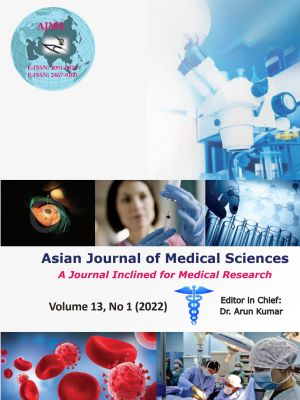Morphology and morphometric study of dry scapula, with emphasis on the glenoid fossa and acromion process in Chennai city, South India
Keywords:
Acromian process, Coracoid process, Glenoid cavity, Morphology, Morphometry, ScapulaAbstract
Background: The morphology and morphometry of the scapula and its glenoid fossa and acromion process play a significant role in the mechanics of shoulder joint. A variable morphology is found in glenoid fossa that has clinical implications.
Aims and Objectives: The aim of the study was to evaluate the morphology and morphometry of dry scapula with emphasis on glenoid fossa and acromion process.
Materials and Methods: A cross-sectional study was conducted at the department of anatomy, for a period of 6 months from January 2021 to June 2021. A total of 100 unpaired dry scapula were included in the study. The morphology and dimensions were measured. The dimensions were summarized as mean and standard deviation. Statistical analysis was done Chi-square test and student’s t-test based on the variable types.
Results: Out of 100 scapulae studied, 48 were right sided and 52 were left sided. The mean of maximum length of the right scapula was 149.58±10.33 mm and the left side was 148.63±10.33 mm. Among the glenoid cavities, 54 were inverted comma shaped, 30 were pear shaped, and 16 were oval shaped. In one right-sided scapula Bony Spur Extends from Base of coracoid process to supra Scapular Notch.
Conclusion: Size and shape of the glenoid cavity are directly related to the dislocation of shoulder joint and may affect the results of total shoulder arthroplasty and rotator cuff surgeries. The present study analyzed the morphological types and diameters of the glenoid cavity in adult scapulae to improve the efficacy and minimize the failure rates in shoulder arthroplasty particularly those involving the glenoid component of the shoulder joint.
Downloads
Downloads
Published
How to Cite
Issue
Section
License
Copyright (c) 2021 Asian Journal of Medical Sciences

This work is licensed under a Creative Commons Attribution-NonCommercial 4.0 International License.
Authors who publish with this journal agree to the following terms:
- The journal holds copyright and publishes the work under a Creative Commons CC-BY-NC license that permits use, distribution and reprduction in any medium, provided the original work is properly cited and is not used for commercial purposes. The journal should be recognised as the original publisher of this work.
- Authors are able to enter into separate, additional contractual arrangements for the non-exclusive distribution of the journal's published version of the work (e.g., post it to an institutional repository or publish it in a book), with an acknowledgement of its initial publication in this journal.
- Authors are permitted and encouraged to post their work online (e.g., in institutional repositories or on their website) prior to and during the submission process, as it can lead to productive exchanges, as well as earlier and greater citation of published work (See The Effect of Open Access).




